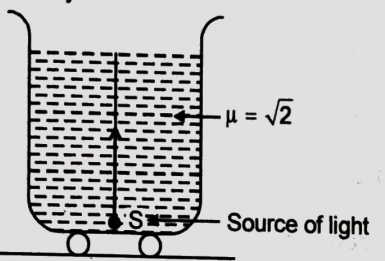A ray of light is incident on an equilateral glass prism placed on a horizontal table as shown. For minimum deviation, a true statement is:

1.
\(PQ\) is horizontal
2.
\(QR\) is horizontal
3.
\(RS\) is horizontal
4.
Either \(PQ\) or \(RS\) is horizontal

Assertion (A): A convex lens made up of glass can never form a virtual, erect, and diminished image.
Reason (R): Convex lens can give only a virtual enlarged image when an object is placed between the focus and pole of the mirror.
(1) Both Assertion and Reason are true and the reason is the correct explanation of the assertion.
(2) Both Assertion and Reason are true but the reason is not the correct explanation of the assertion.
(3) Assertion is a true statement but Reason is false.
(4) Both Assertion and Reason are false statements.
The length of a compound microscope is 14 cm. The magnifying power for a relaxed eye is 25. If the focal length of the eye lens is 5 cm, then the object distance for the objective lens will be
1. 1.8 cm
2. 1.5 cm
3. 2.1 cm
4. 2.4 cm
Assertion: When a convex mirror is immersed in water, its focal length increases.
Reason: The focal length of a mirror is inversely proportional to the refractive index of the medium.
(1) Both Assertion and Reason are true and the reason is the correct explanation of the assertion.
(2) Both Assertion and Reason are true but the reason is not the correct explanation of the assertion.
(3) Assertion is a true statement but Reason is false.
(4) Both Assertion and Reason are false statements.
A point source of light is emitting light in a vertically upward direction and the container is filled with a liquid of refractive index . If it starts accelerating along the x-axis with acceleration , the light coming out of liquid os deviated by
1.
2.
3.
4.
The minimum magnifying power of a telescope is M. If the focal length of its eye lens is halved, then the magnifying power will become
1.
2. 2M
3. 3M
4. 4M
Given below are two statements:
| Assertion (A): | A beam of white light passing through a thin hollow prism does not give spectrum. |
| Reason (R): | The speed of light inside and outside the prism is same. |
| 1. | Both (A) and (R) are true and (R) is the correct explanation of (A). |
| 2. | Both (A) and (R) are true but (R) is not the correct explanation of (A). |
| 3. | (A) is true but (R) is false. |
| 4. | Both (A) and (R) are false. |
Given below are two statements:
| Assertion (A): | When white light is incident on a prism it will disperse. |
| Reason (R): | The refractive index of a medium depends on the wavelength of light. |
| 1. | Both (A) and (R) are true and (R) is the correct explanation of (A). |
| 2. | Both (A) and (R) are true but (R) is not the correct explanation of (A). |
| 3. | (A) is true but (R) is false. |
| 4. | Both (A) and (R) are false. |
A compound microscope has an objective lens with a focal length of \(1.5~\text{cm}\) and an eyepiece of focal length \(5~\text{cm}\). It is focussed on an object which is at a distance of \(1.8~\text{cm}\). The length of the microscope for normal adjustment is:
1. \(14~\text{cm}\)
2. \(2~\text{cm}\)
3. \(19~\text{cm}\)
4. \(9.5~\text{cm}\)
| 1. | \(\frac{\sqrt{3}}{2} \) | 2. | \(1.5 \) |
| 3. | \(1.732 \) | 4. | \( 2\) |






